Spatiotemporal Variation Characteristics of Ecosystem Service Losses in the Agro-Pastoral Ecotone of Northern China
Abstract
:1. Introduction
2. Materials and Methods
2.1. Study Area
2.2. Assignment of Ecosystem Service Values (ESV)
2.3. Calculating ESV Losses
2.4. Data Sources
2.5. Data Statistical Analysis
3. Results
3.1. Spatiotemporal Processes of Land-Use Conversions in the Agro-Pastoral Ecotone
3.2. Analysis of ESV Losses in the Agro-Pastoral Ecotone
3.3. Variance Analysis and Trend Analysis of Precipitation, Temperature and Population in the Agro-Pastoral Ecotone
4. Discussion
4.1. Human Interferences Led to ESV Losses in the Agro-Pastoral Ecotone Losing
4.2. Natural Factors that Have Led to ESV Losses in the Agro-Pastoral Ecotone
4.3. Ecological Protection Policies Implemented in the Agro-Pastoral Ecotone
4.4. Validity and Limitations of This Study
5. Conclusions
Supplementary Materials
Author Contributions
Funding
Conflicts of Interest
Appendix A. Moving Weighted Trend Surface Analysis
Appendix B. Mann-Kendall Trend Test
Appendix C. Standard Deviation Ellipse Analysis
Appendix D. Dynamic ESV Assessment Method
References
- Rindfuss, R.R.; Walsh, S.J.; Turner, B.L.; Jefferson, F.; Vinod, M. Developing a science of land change: Challenges and methodological issues. Proc. Natl. Acad. Sci. USA 2004, 101, 13976–13981. [Google Scholar] [CrossRef] [PubMed] [Green Version]
- Carlson, B.Z.; Renaud, J.; Biron, P.E.; Choler, P. Long-term modeling of the forest-grassland ecotone in the French Alps: Implications for land management and conservation. Ecol. Appl. 2014, 24, 1213–1225. [Google Scholar] [CrossRef]
- Collard, S.J.; Zammit, C. Effects of land-use intensification on soil carbon and ecosystem services in Brigalow (Acacia harpophylla) landscapes of southeast Queensland, Australia. Agric. Ecosyst. Environ. 2006, 117, 185–194. [Google Scholar] [CrossRef] [Green Version]
- Bateman, I.J.; Harwood, A.R.; Mace, G.M.; Watson, R.T.; Abson, D.J.; Barnaby, A.; Amy, B.; Andrew, C.; Day, B.H.; Steve, D. Bringing ecosystem services into economic decision-making: Land use in the United Kingdom. Science 2013, 341, 45–50. [Google Scholar] [CrossRef] [PubMed]
- Haberl, H.; Erb, K.H.; Krausmann, F.; Loibl, W.; Weisz, H. Changes in ecosystem processes induced by land use: Human appropriation of aboveground NPP and its influence on standing crop in Austria. Glob. Biogeochem. Cycles 2001, 15, 929–942. [Google Scholar] [CrossRef] [Green Version]
- Zhou, P.; Liu, G.B. The change in values for ecological footprint indices following land-use change in a Loess Plateau watershed in China. Environ. Earth Sci. 2009, 59, 529–536. [Google Scholar] [CrossRef]
- Cui, J.; Zang, S.Y. Regional disparities of land use changes and their eco-environmental effects in Harbin-Daqing-Qiqihar Industrial Corridor. Geogr. Res. 2013, 34, 280–287. (In Chinese) [Google Scholar]
- Fei, L.; Zhang, S.W.; Yang, J.C.; Chang, L.P.; Yang, H.J.; Bu, K. Effects of land use change on ecosystem services value in West Jilin since the reform and opening of China. Ecosyst. Serv. 2018, 31, 12–20. [Google Scholar] [CrossRef]
- Costanza, R.; d’Arge, R.; de Groot, R.; Farber, S.; Grasso, M.; Hannon, B.; Limburg, K.; Naeem, S.; ONeill, R.V.; Paruelo, J.; et al. The value of the world’s ecosystem services and natural capital. Nature 1997, 387, 253–260. [Google Scholar] [CrossRef]
- Wei, S.; Deng, X.Z.; Yuan, Y.W.; Zhan, W.; Li, Z.H. Impacts of land-use change on valued ecosystem service in rapidly urbanized North China Plain. Ecol. Model. 2015, 318, 245–253. [Google Scholar] [Green Version]
- Lambin, E.F.; Ehrlich, D. Land-cover changes in sub-saharan Africa (1982–1991): Application of a change index based on remotely sensed surface temperature and vegetation indices at a continental scale. Remote Sens. Environ. 1997, 61, 181–200. [Google Scholar] [CrossRef]
- Schröter, D.; Cramer, W.; Leemans, R.; Prentice, I.C.; Araújo, M.B.; Arnell, N.W.; Bondeau, A.; Bugmann, H.; Carter, T.R.; Gracia, C.A.; et al. Ecosystem service supply and vulnerability to global change in Europe. Science 2005, 310, 1333–1337. [Google Scholar] [CrossRef]
- Peng, J.; Wang, Y.; Wu, J.; Yue, J.; Zhang, Y.; Li, W. Ecological effects associated with land-use change in China’s southwest agricultural landscape. Int. J. Sustain. Dev. World Ecol. 2006, 13, 315–325. [Google Scholar] [CrossRef]
- Nahuelhual, L.; Carmona, A.; Aguayo, M.; Echeverria, C. Land use change and ecosystem services provision: A case study of recreation and ecotourism opportunities in southern Chile. Landsc. Ecol. 2014, 29, 329–344. [Google Scholar] [CrossRef]
- Song, W.; Deng, X.Z. Land-use/land-cover change and ecosystem service provision in China. Sci. Total Environ. 2017, 576, 705–719. [Google Scholar] [CrossRef]
- Fei, L.; Zhang, S.W.; Yang, J.C.; Bu, K.; Wang, Q.; Tang, J.M.; Chang, L.P. The effects of population density changes on ecosystem services value: A case study in Western Jilin, China. Ecol. Indic. 2016, 61, 328–337. [Google Scholar] [CrossRef]
- Ma, F.J.; Eneji, A.E.; Liu, J.T. Assessment of ecosystem services and dis-services of an agro-ecosystem based on extended emergy framework: A case study of Luancheng county, North China. Ecol. Eng. 2015, 82, 241–251. [Google Scholar] [CrossRef]
- Su, S.L.; Rui, X.; Jiang, Z.L.; Yuan, Z. Characterizing landscape pattern and ecosystem service value changes for urbanization impacts at an eco-regional scale. Appl. Geogr. 2012, 34, 295–305. [Google Scholar] [CrossRef]
- Zhao, S.Q. Ximeng-An economic geography investigation of farming-pastoral region of Northern China. J. Geogr. Sci. 1953, 19, 43–60. (In Chinese) [Google Scholar]
- Zhao, H.L.; Zhao, X.Y.; Zhang, T.H.; Zhou, R.L. Boundary line on Agro-pasture Zigzag Zone in North China and its problems on eco-environment. Adv. Earth Sci. 2002, 17, 739–747. (In Chinese) [Google Scholar]
- Gao, J.X.; Lv, S.H.; Zheng, Z.R.; Liu, J.H. Typical ecotones in China. J. Resour. Ecol. 2012, 3, 297–307. [Google Scholar]
- Wang, T.; Xue, X.; Zhou, L.; Guo, J. Combating aeolian desertification in Northern China. Land Degrad. Dev. 2015, 26, 118–132. [Google Scholar] [CrossRef]
- Zhai, X.J.; Huang, D.; Tang, S.; Li, S.Y.; Guo, J.X.; Yang, Y.J.; Liu, H.F.; Li, J.S.; Wang, K. The emergy of metabolism in different ecosystems under the same environmental conditions in the agro-pastoral ecotone of Northern China. Ecol. Indic. 2017, 74, 198–204. [Google Scholar] [CrossRef]
- Jia, H.C.; Pan, D.H.; Wang, J.A.; Zhang, W.C. Risk mapping of integrated natural disasters in China. Nat. Hazards 2016, 80, 2023–2035. [Google Scholar] [CrossRef]
- Liu, J.Y.; Kuang, W.H.; Zhang, Z.X.; Xu, X.L.; Qin, Y.W.; Ning, J.; Zhou, W.C.; Zhang, S.W.; Li, R.D.; Yan, C.Z.; et al. Spatiotemporal characteristics, patterns, and causes of land-use changes in China since the late 1980s. J. Geogr. Sci. 2014, 24, 195–210. [Google Scholar] [CrossRef]
- Li, F.; Zheng, J.; Wang, H.; Luo, J.; Zhao, Y.; Zhao, R. Mapping grazing intensity using remote sensing in the Xilingol steppe region, Inner Mongolia, China. Remote Sens. Lett. 2016, 7, 328–337. [Google Scholar] [CrossRef]
- Zhang, A.P.; Zhang, H. Effects of land use change on ecosystem service values in Chifeng City. Acta Sci. Natl. Univ. Neimongol. 2007, 22, 527–532. (In Chinese) [Google Scholar]
- Wu, W.H.; Peng, J.; Liu, Y.X.; Hu, Y.N. Tradeoffs and synergies between ecosystem services in Ordos City. Prog. Geogr. 2017, 36, 1571–1581. (In Chinese) [Google Scholar]
- Liu, J.H.; Gao, J.X. Measurement and dynamic change of ecosystem services value in the farming-pastoral ecotone of Northern China. J. Mt. Sci. 2008, 26, 145–153. [Google Scholar]
- He, J.; Kuhn, N.J.; Zhang, X.M.; Zhang, X.R.; Li, H.W. Effects of 10 years of conservation tillage on soil properties and productivity in the farming-pastoral ecotone of Inner Mongolia, China. Soil Use Manag. 2010, 25, 201–209. [Google Scholar] [CrossRef]
- Li, S.J.; Sun, Z.G.; Tan, M.H.; Guo, L.L.; Zhang, X.B. Changing patterns in farming–pastoral ecotones in China between 1990 and 2010. Ecol. Indic. 2018, 89, 110–117. [Google Scholar] [CrossRef]
- Wang, X.Y.; Li, Y.Q.; Chen, Y.P.; Lian, J.; Luo, Y.Q.; Niu, Y.Y.; Gong, X.W.; Yu, P.D. Temporal and spatial variation of extreme temperatures in an agro-pastoral ecotone of Northern China from 1960 to 2016. Sci. Rep.-UK 2018, 8, 1–14. [Google Scholar] [CrossRef]
- Xie, G.D.; Zhang, C.X.; Zhang, L.M.; Chen, W.H.; Li, S.M. Improvement of the evaluation method for ecosystem service value based on per unit area. J. Nat. Resour. 2015, 30, 1243–1254. (In Chinese) [Google Scholar]
- Liu, X.H.; Jiang, M.; Dong, G.H.; Zhang, Z.S.; Wang, X.G. Ecosystem service comparison before and after marshland conversion to paddy field in the Sanjiang Plain, Northeast China. Wetlands 2017, 37, 593–600. [Google Scholar] [CrossRef]
- Xie, G.D.; Zhang, C.X.; Zhen, L.; Zhang, L.M. Dynamic changes in the value of China’s ecosystem services. Ecosyst. Serv. 2017, 26, 146–154. [Google Scholar] [CrossRef]
- Liu, J.Y.; Liu, M.L.; Tian, H.Q.; Zhuang, D.F.; Zhang, Z.X.; Zhang, W.; Tang, X.M.; Deng, X.Z. Spatial and temporal patterns of China’s cropland during 1990–2000: An analysis based on Landsat TM data. Remote Sens. Environ. 2005, 98, 442–456. [Google Scholar] [CrossRef]
- Liu, J.Y.; Zhang, Z.X.; Xu, X.L.; Kuang, W.H.; Zhou, W.C.; Zhang, S.W.; Li, R.D.; Yan, C.Z.; Yu, D.S.; Wu, S.X. Spatial patterns and driving forces of land use change in China during the early 21st century. J. Geogr. Sci. 2010, 20, 483–494. [Google Scholar] [CrossRef]
- Zhu, W.Q.; Pan, Y.Z. Estimation of net primary productivity of Chinese terrestrial vegetation based on remote sensing. J. Plant Ecol. 2007, 31, 413–424. [Google Scholar]
- Eppler, D.T.; Full, W.E. Polynomial trend surface analysis applied to AVHRR images to improve definition of arctic leads. Remote Sens. Environ. 1992, 40, 197–218. [Google Scholar] [CrossRef] [Green Version]
- Bai, X.; Wang, P.; Wang, H.; Xie, Y. An up-scaled vegetation temperature condition index retrieved from landsat data with trend surface analysis. IEEE J.-Stars 2017, 10, 3537–3546. [Google Scholar] [CrossRef]
- Jian, P.; Sha, C.; Lü, H.L.; Liu, Y.X.; Wu, J.S. Spatiotemporal patterns of remotely sensed PM 2.5 concentration in China from 1999 to 2011. Remote Sens. Environ. 2016, 174, 109–121. [Google Scholar]
- Wachowicz, M.; Liu, T.Y. Finding spatial outliers in collective mobility patterns coupled with social ties. Int. J. Geogr. Inf. Sci. 2016, 30, 1–26. [Google Scholar] [CrossRef]
- Brereton, R.G. Consequences of sample size, variable selection, and model validation and optimisation, for predicting classification ability from analytical data. TrAC-Trends Anal. Chem. 2006, 25, 1103–1111. [Google Scholar] [CrossRef]
- Bai, P.; Wang, J.; Yin, H.; Tian, Y.; Yao, W.; Gao, J. Discrimination of human and nonhuman blood by raman spectroscopy and partial least squares discriminant analysis. Anal. Lett. 2016, 50, 379–388. [Google Scholar] [CrossRef]
- Brereton, R.G.; Lloyd, G.R. Partial least squares discriminant analysis: Taking the magic away. J. Chemometr. 2014, 28, 213–225. [Google Scholar] [CrossRef]
- Bassbasi, M.; De Luca, M.; Ioele, G.; Oussama, A.; Ragno, G. Prediction of the geographical origin of butters by partial least square discriminant analysis (PLS-DA) applied to infrared spectroscopy (FTIR) data. J. Food Compos. Anal. 2014, 33, 210–215. [Google Scholar] [CrossRef]
- Chen, H.; Lin, Z.; Tan, C. Nondestructive discrimination of pharmaceutical preparations using near-infrared spectroscopy and partial least-squares discriminant analysis. Anal. Lett. 2018, 51, 564–574. [Google Scholar] [CrossRef]
- Tong, Z.Y.; Tong, M.M.; Liu, B.; Li, M. Research on gas emission distribution in coalface based on trend surface polynomial analysis. IEEE Sens. J. 2015, 15, 164–171. [Google Scholar] [CrossRef]
- Kang, H.; Seely, B.; Wang, G.; Innes, J.; Zheng, D.; Chen, P.; Wang, T.; Li, Q. Evaluating management tradeoffs between economic fiber production and other ecosystem services in a Chinese-fir dominated forest plantation in Fujian Province. Sci. Total Environ. 2016, 557–558, 80–90. [Google Scholar] [CrossRef] [PubMed]
- Reno, V.; Novo, E.; Escada, M. Forest fragmentation in the lower Amazon floodplain: Implications for biodiversity and ecosystem service provision to riverine populations. Remote Sens. 2016, 8, 886. [Google Scholar] [CrossRef]
- Dessaint, F.; Caussanel, J.P. Trend surface analysis: A simple tool for modelling spatial patterns of weeds. Crop Prot. 1994, 13, 433–438. [Google Scholar] [CrossRef]
- Wang, H.C.; Zuo, R.G. A comparative study of trend surface analysis and spectrum-area multifractal model to identify geochemical anomalies. J. Geochem. Explor. 2015, 155, 84–90. [Google Scholar] [CrossRef]
- Ye, Y. Expansion of cropland area and formation of the eastern farming-pastoral ecotone in Northern China during the twentieth century. Reg. Environ. Chang. 2012, 12, 923–934. [Google Scholar] [CrossRef]
- Liu, C.; Xu, Y.Q.; Sun, P.L.; Huang, A.; Zheng, W.R. Land use change and its driving forces toward mutual conversion in Zhangjiakou City, a farming-pastoral ecotone in Northern China. Environ. Monit. Assess. 2017, 189, 1–20. [Google Scholar] [CrossRef] [PubMed]
- Hao, F.; Lai, X.; Ouyang, W.; Xu, Y.; Wei, X.; Song, K. Effects of land use changes on the ecosystem service values of a reclamation farm in northeast China. Environ. Manag. 2012, 50, 888–899. [Google Scholar] [CrossRef] [PubMed]
- Wei, B.C.; Xie, Y.W.; Xu, J.; Wang, X.Y.; He, H.J.; Xue, X.Y. Land use/land cover change and it’s impacts on diurnal temperature range over the agricultural pastoral ecotone of Northern China. Land Degrad. Dev. 2018, 29, 3009–3020. [Google Scholar] [CrossRef]
- Shi, W.J.; Tao, F.L.; Liu, J.Y.; Xu, X.L.; Kuang, W.H.; Dong, J.W.; Shi, X.L. Has climate change driven spatio-temporal changes of cropland in Northern China since the 1970s? Clim. Chang. 2014, 124, 163–177. [Google Scholar] [CrossRef]
- Eckert, S.; Hüsler, F.; Liniger, H.; Hodel, E. Trend analysis of MODIS NDVI time series for detecting land degradation and regeneration in Mongolia. J. Arid. Environ. 2015, 113, 16–28. [Google Scholar] [CrossRef]
- Wang, J.A.; Xu, X.; Liu, P.F. Land use and land carrying capacity in ecotone between agriculture and animal husbandry in Northern China. Resour. Sci. 1999, 21, 19–24. [Google Scholar]
- Dai, G.S.; Ulgiati, S.; Zhang, Y.S.; Yu, B.H.; Kang, M.Y.; Jin, Y.; Dong, X.B.; Zhang, X.S. The false promises of coal exploitation: How mining affects herdsmen well-being in the grassland ecosystems of Inner Mongolia. Energy Policy 2015, 67, 146–153. [Google Scholar] [CrossRef]
- Liu, J.H.; Gao, J.X.; Lv, S.H.; Han, Y.W.; Nie, Y.H. Shifting farming-pastoral ecotone in China under climate and land use changes. J. Arid. Environ. 2011, 75, 298–308. [Google Scholar] [CrossRef]
- Batunacun; Nendel, C.; Hu, Y.F.; Lakes, T. Land-use change and land degradation on the Mongolian Plateau from 1975 to 2015-A case study from Xilingol, China. Land Degrad. Dev. 2018, 29, 1595–1606. [Google Scholar] [CrossRef] [Green Version]
- Yan, F.Q.; Zhang, S.W.; Liu, X.T.; Chen, D.; Chen, J.; Bu, K.; Yang, J.C.; Chang, L.P. The effects of spatiotemporal changes in land degradation on ecosystem services values in Sanjiang Plain, China. Remote Sens. 2016, 8, 917. [Google Scholar] [CrossRef]
- Carvalho-Santos, C.; Monteiro, A.T.; Arenas-Castro, S.; Greifeneder, F.; Marcos, B.; Portela, A.P.; Honrado, J.P. Ecosystem services in a protected mountain range of portugal: Satellite-based products for state and trend analysis. Remote Sens. 2018, 10, 1573. [Google Scholar] [CrossRef]
- Xie, G.D.; Zhen, L.; Lu, C.X.; Xiao, Y.; Chen, C. Expert knowledge based valuation method of ecosystem services in China. J. Nat. Resour. 2008, 23, 911–919. (In Chinese) [Google Scholar]
- Zhang, B.A.; Li, W.H.; Xie, G.D. Ecosystem services research in China: Progress and perspective. Ecol. Econ. 2010, 69, 1389–1395. [Google Scholar] [CrossRef]
- Sun, J. Research advances and trends in ecosystem services and evaluation in China. Procedia Environ. Sci. 2011, 10, 1791–1796. [Google Scholar]
- Yu, Z.Y.; Bi, H. The key problems and future direction of ecosystem services research. Energy Procedia 2011, 5, 64–68. [Google Scholar] [CrossRef]
- Naidoo, R.; Balmford, A.; Costanza, R.; Fisher, B.; Green, R.E.; Lehner, B.; Malcolm, T.R.; Ricketts, T.H. Global mapping of ecosystem services and conservation priorities. Proc. Natl. Acad. Sci. USA 2008, 105, 9495–9500. [Google Scholar] [CrossRef] [PubMed] [Green Version]
- Eigenbrod, F.; Armsworth, P.R.; Anderson, B.J.; Heinemeyer, A.; Gillings, S.; Roy, D.B.; Thomas, C.D.; Gaston, K.J. The impact of proxy-based methods on mapping the distribution of ecosystem services. J. Appl. Ecol. 2010, 47, 377–385. [Google Scholar] [CrossRef] [Green Version]
- Martínez-Harms, M.-J.; Balvanera, P. Methods for mapping ecosystem service supply: A review. Int. J. Biodivers. Science Ecosyst. Serv. Manag. 2012, 8, 17–25. [Google Scholar]
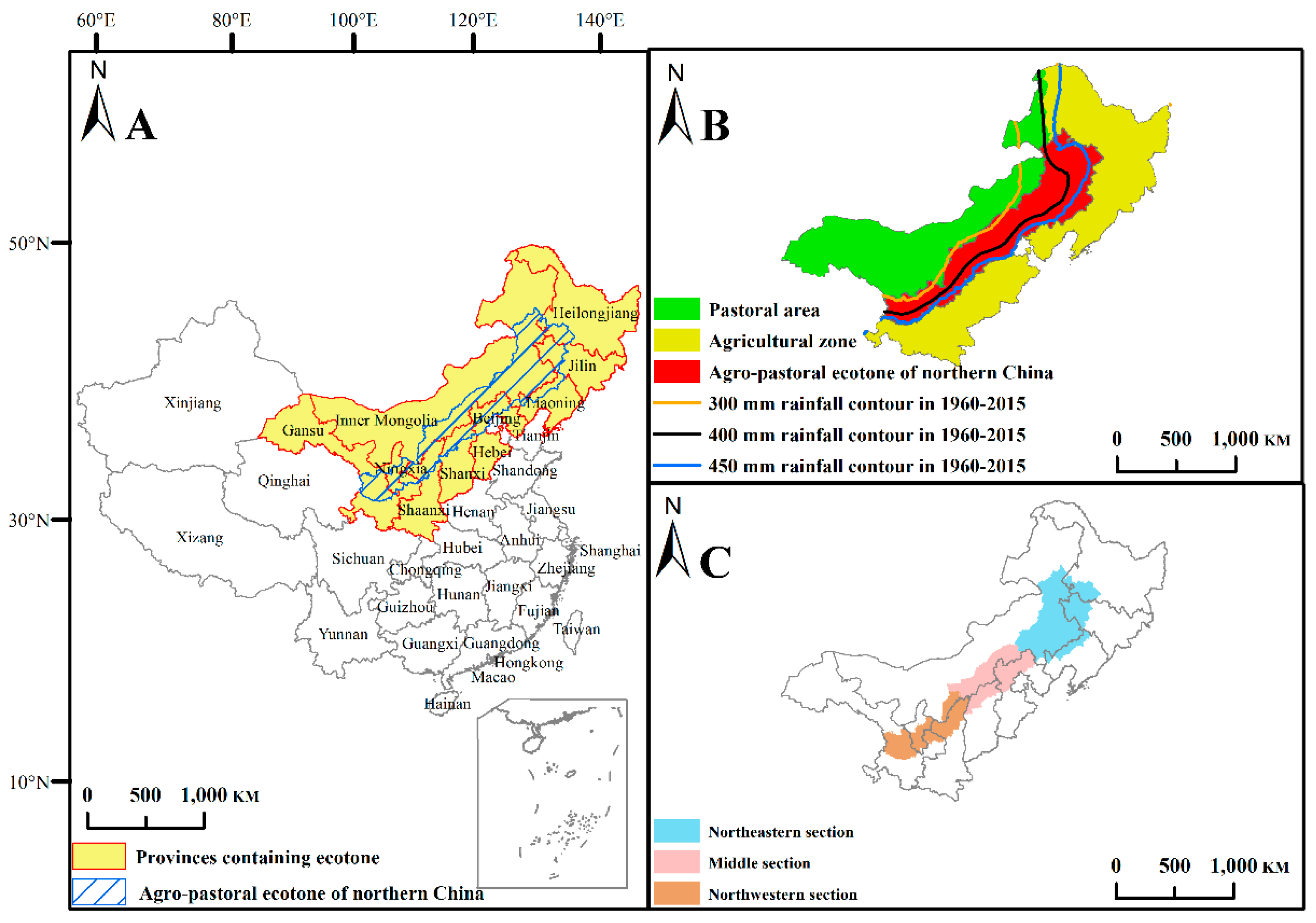

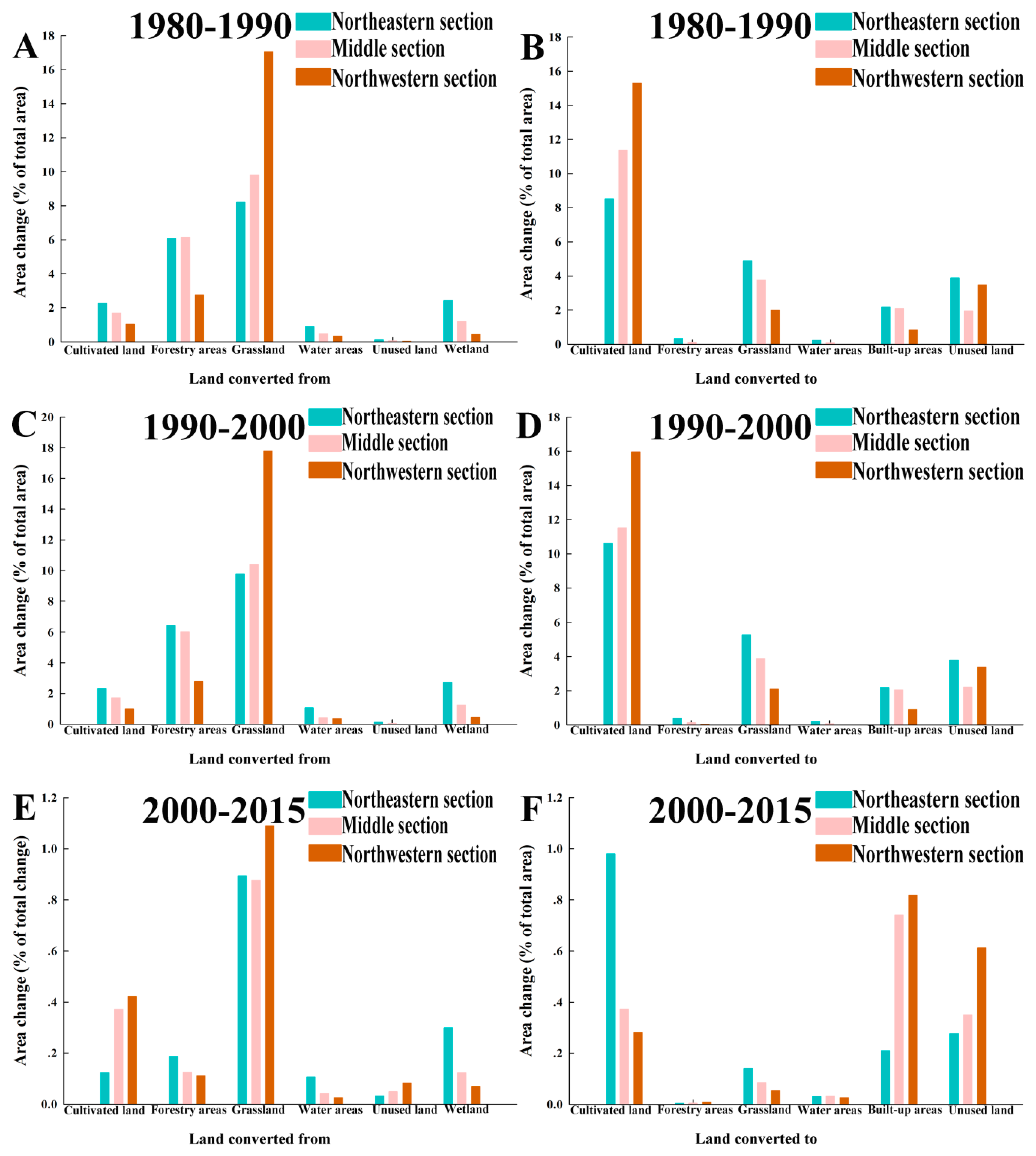

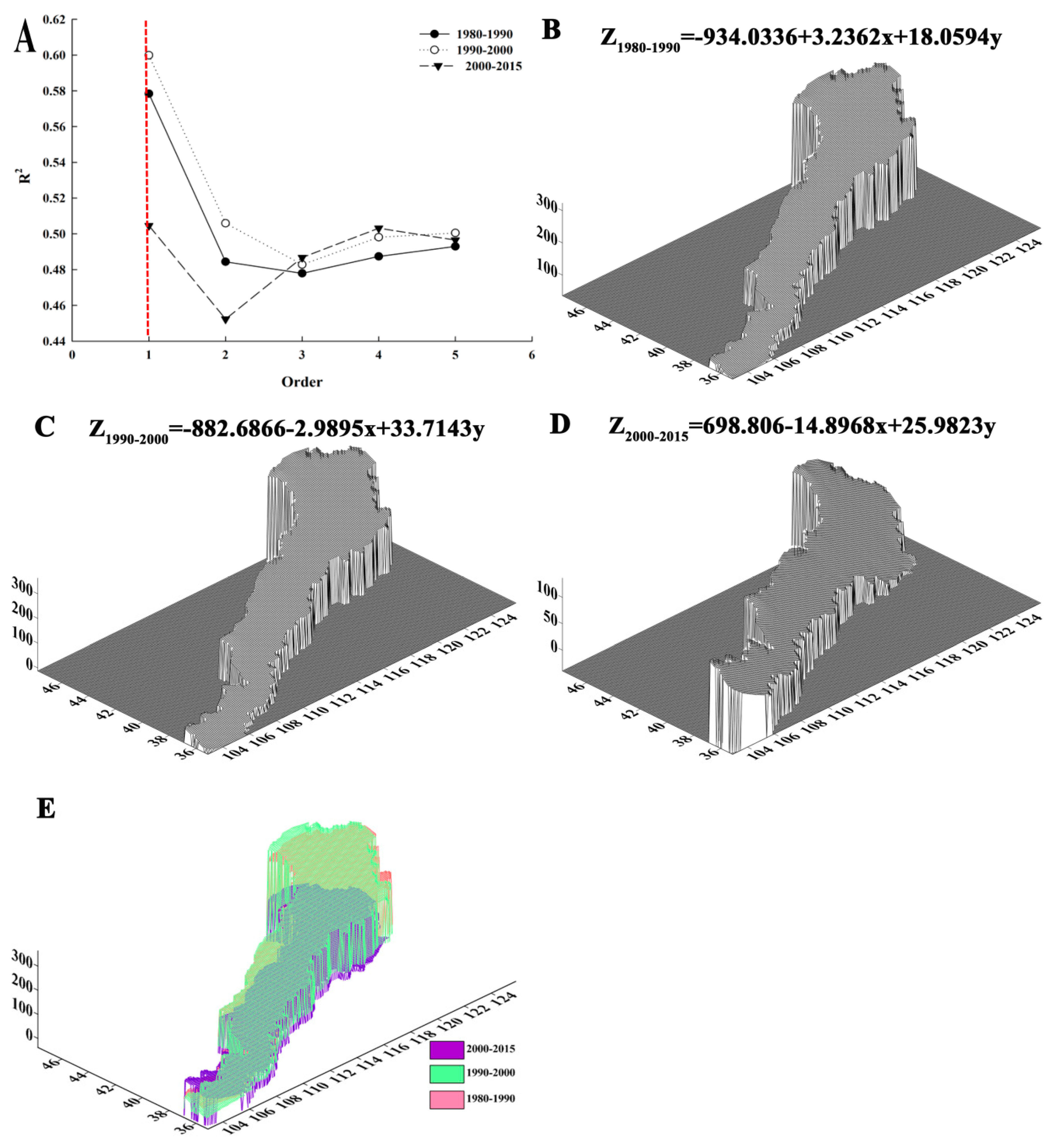
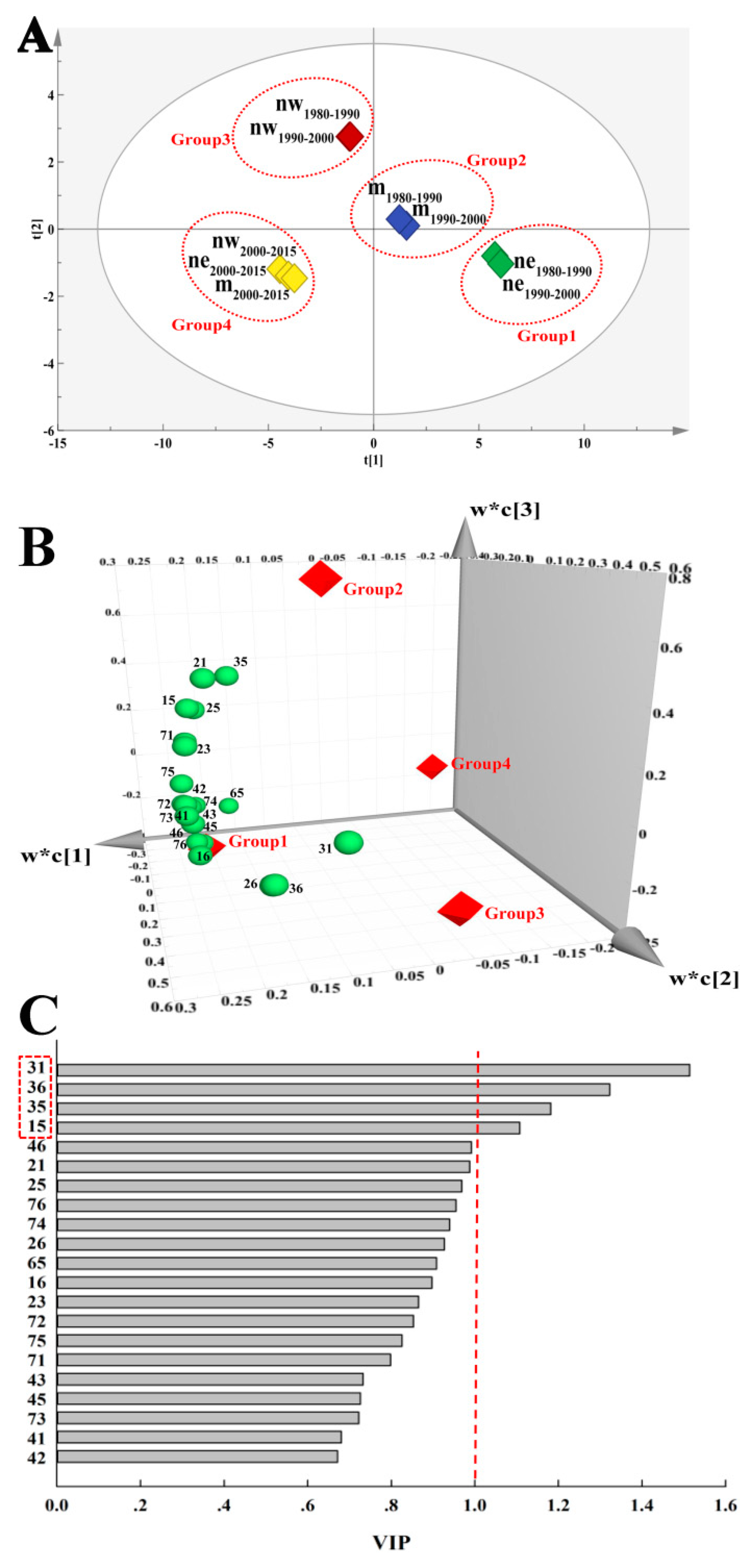
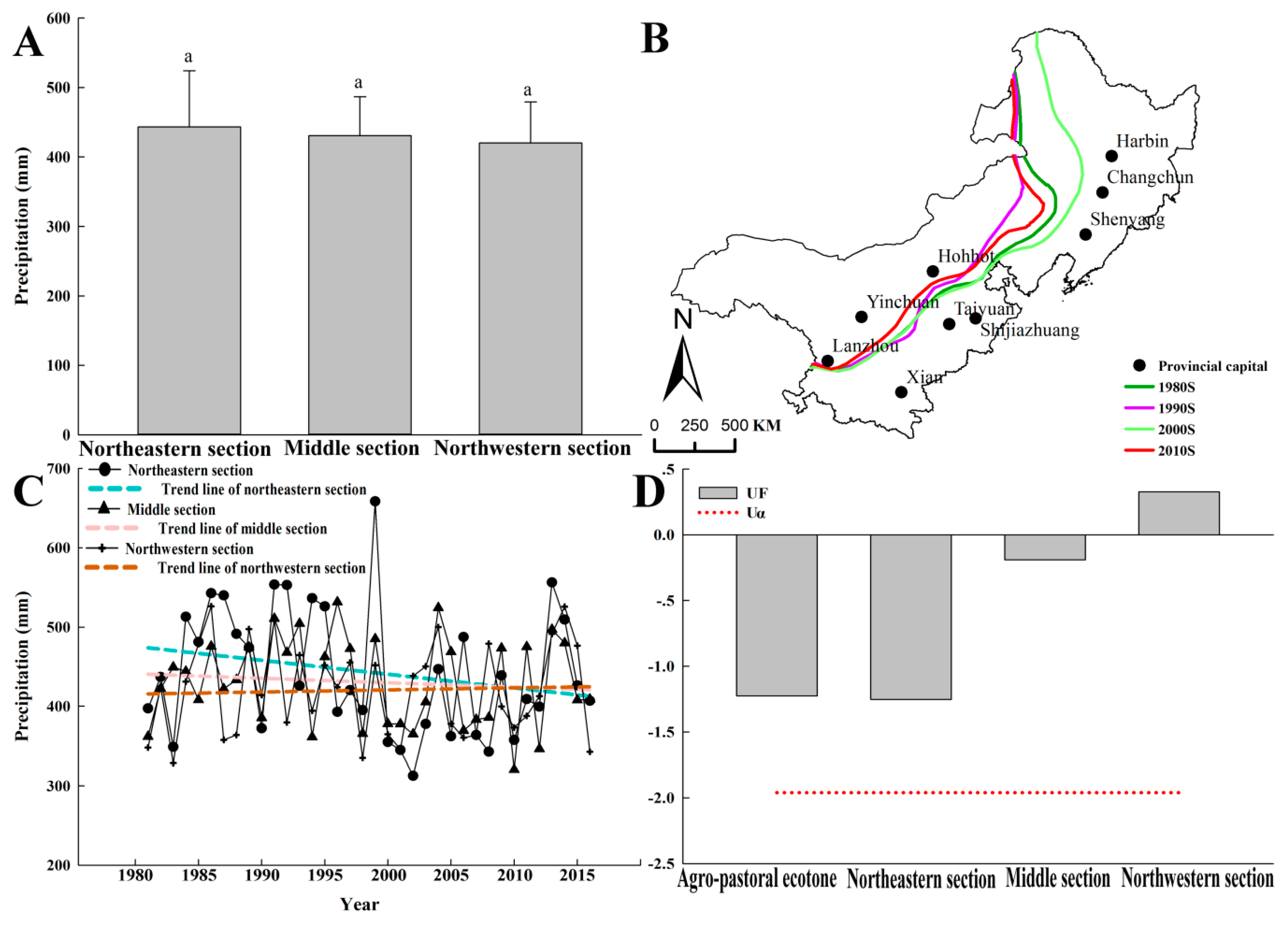
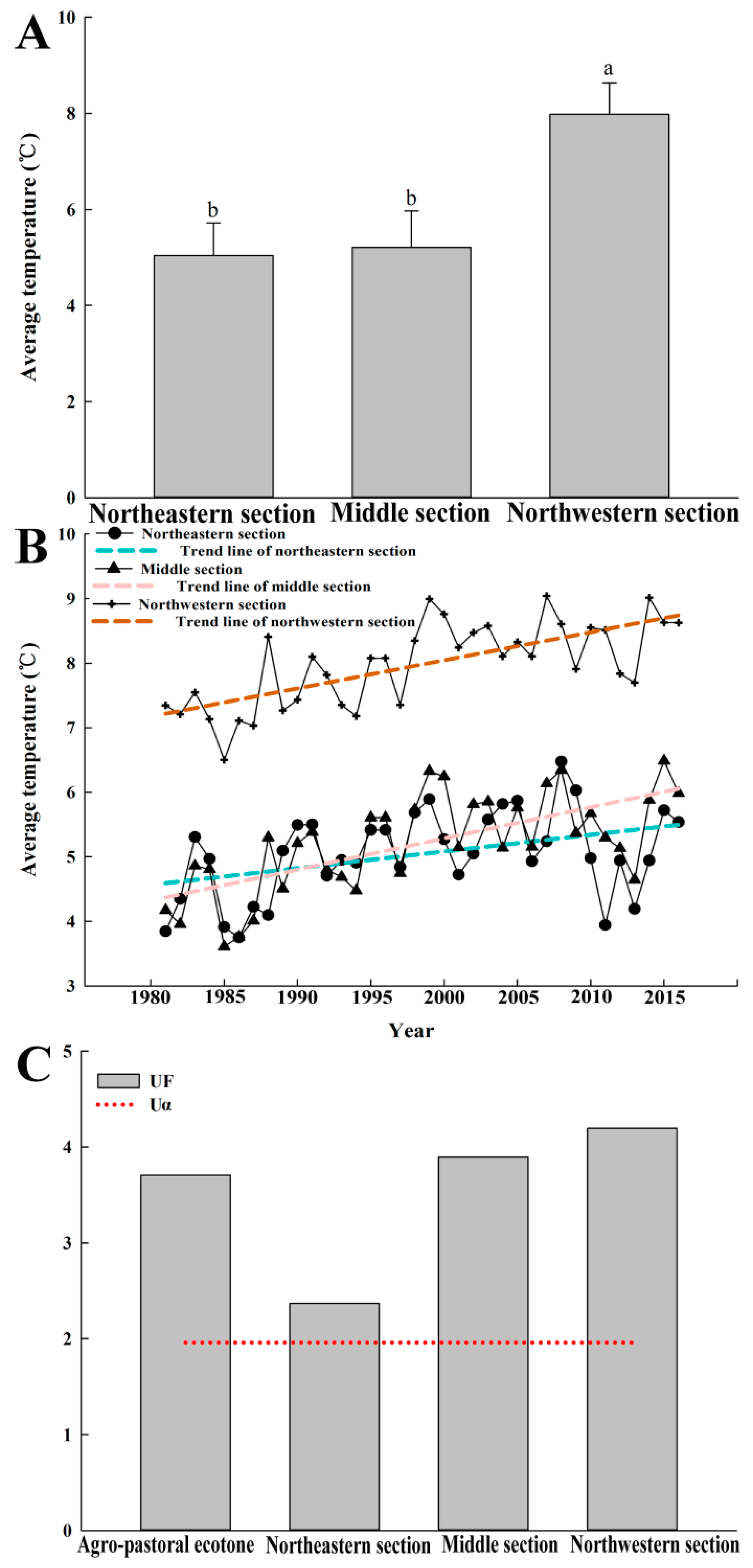

| 1 Cultivated Land | 2 Forestry Areas | 3 Grassland | 4 Water Areas | 5 Built-Up Areas | 6 Unused Land | 7 Wetland | |
|---|---|---|---|---|---|---|---|
| 1 Cultivated land | 15 | 16 | |||||
| 2 Forestry areas | 21 | 23 | 25 | 26 | |||
| 3 Grassland | 31 | 35 | 36 | ||||
| 4 Water areas | 41 | 42 | 43 | 45 | 46 | ||
| 5 Built-up areas | |||||||
| 6 Unused land | 65 | ||||||
| 7 Wetland | 71 | 72 | 73 | 74 | 75 | 76 |
© 2019 by the authors. Licensee MDPI, Basel, Switzerland. This article is an open access article distributed under the terms and conditions of the Creative Commons Attribution (CC BY) license (http://creativecommons.org/licenses/by/4.0/).
Share and Cite
Yang, Y.; Wang, K.; Liu, D.; Zhao, X.; Fan, J.; Li, J.; Zhai, X.; Zhang, C.; Zhan, R. Spatiotemporal Variation Characteristics of Ecosystem Service Losses in the Agro-Pastoral Ecotone of Northern China. Int. J. Environ. Res. Public Health 2019, 16, 1199. https://doi.org/10.3390/ijerph16071199
Yang Y, Wang K, Liu D, Zhao X, Fan J, Li J, Zhai X, Zhang C, Zhan R. Spatiotemporal Variation Characteristics of Ecosystem Service Losses in the Agro-Pastoral Ecotone of Northern China. International Journal of Environmental Research and Public Health. 2019; 16(7):1199. https://doi.org/10.3390/ijerph16071199
Chicago/Turabian StyleYang, Yuejuan, Kun Wang, Di Liu, Xinquan Zhao, Jiangwen Fan, Jinsheng Li, Xiajie Zhai, Cong Zhang, and Ruyi Zhan. 2019. "Spatiotemporal Variation Characteristics of Ecosystem Service Losses in the Agro-Pastoral Ecotone of Northern China" International Journal of Environmental Research and Public Health 16, no. 7: 1199. https://doi.org/10.3390/ijerph16071199





